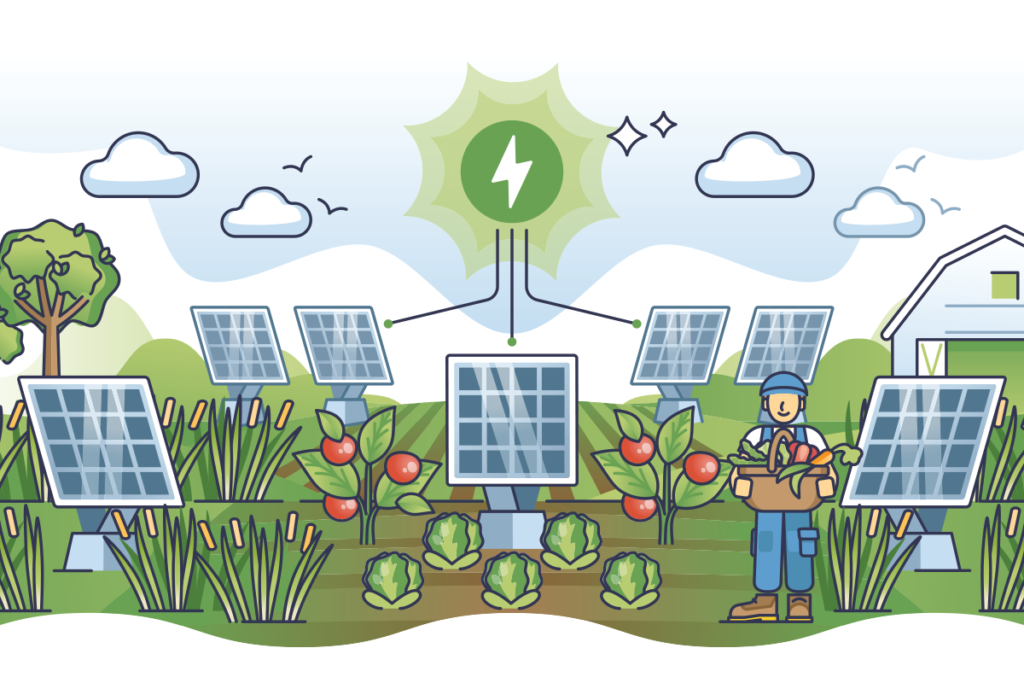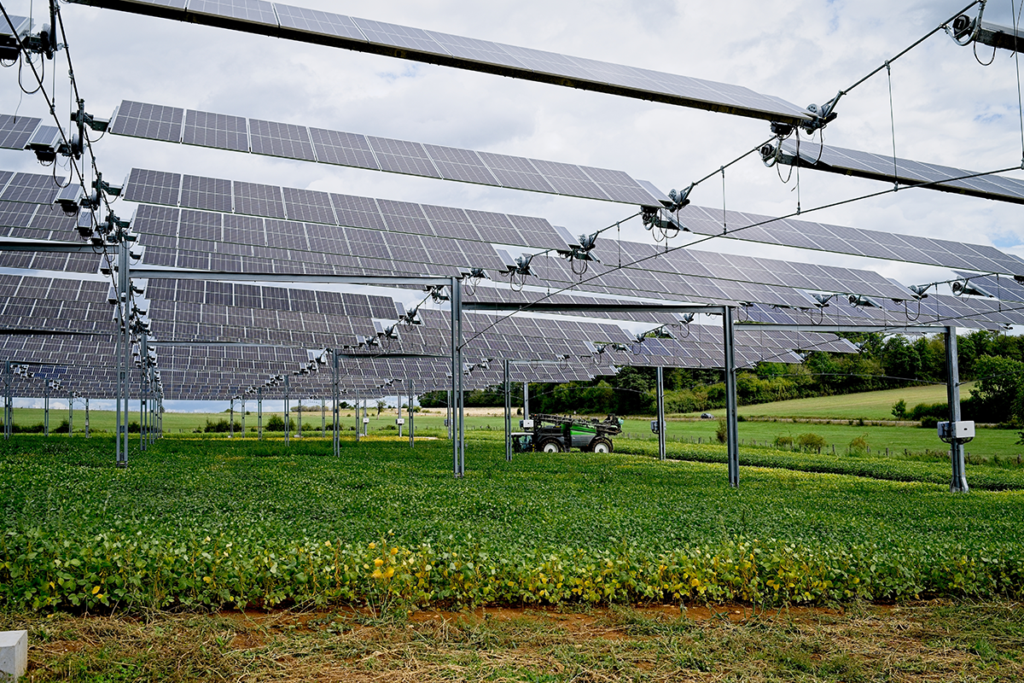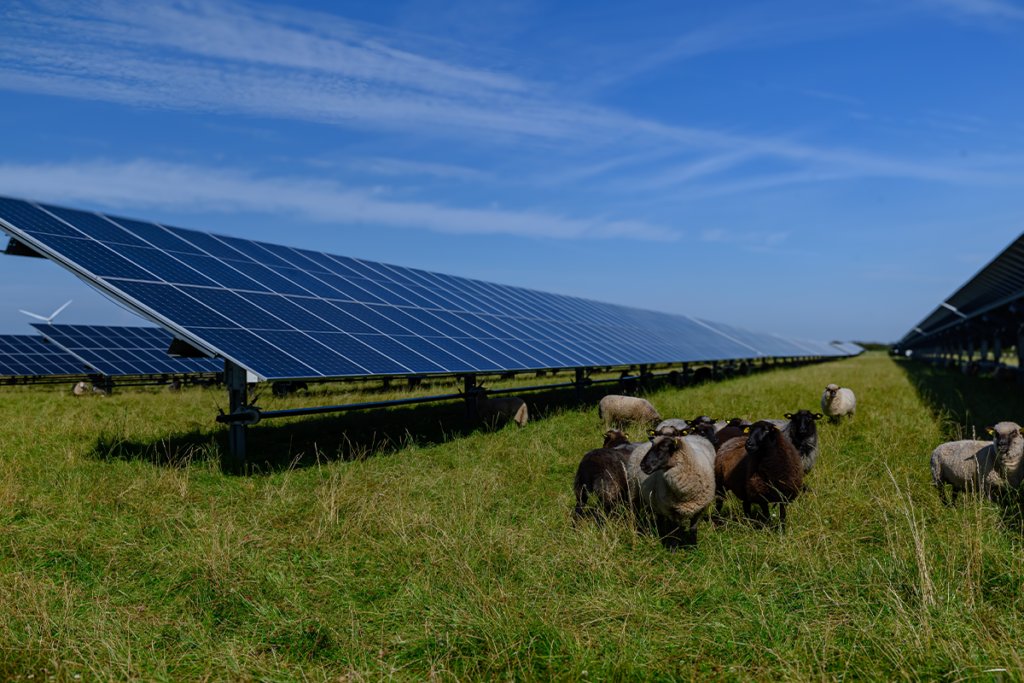We love backyard cookouts as much as the next person. Sizzling burgers, crisp leafy lettuce, and creamy condiments. Yum. But very rarely do we think about where our burgers, veggies, and condiments come from.
Around 90% of what Americans eat is grown domestically— right here in the USA. And that takes a lot of land! We dedicate almost 1.2 billion acres of land to agriculture. That is 53% of the land in the United States, including Alaska and Hawaii. That land is used for crop growing, livestock grazing, and all sorts of agricultural activities.
But large, utility-scale solar farms also take up a lot of land. So what if we combine land usage? Can we combine two problems for one solution?
What are Agrivoltaics?
Agrivoltaics, sometimes called Agrophotovoltaics or just APV, is the dual usage of land for solar power production and agricultural purposes.
Have you ever seen rows of crops covered by elevated solar panels? Or chickens grazing the bug-filled vegetation of solar farms? Greenhouses with solar panels on top? Or maybe you’ve seen rows of farmland separated by vertical standing solar panels.
All are examples of agrivoltaics. And they highlight how diverse agrivoltaic projects can be.
How do Agrivoltaics work? How do they benefit the farmers? Or do the solar panels benefit from the farmland? Are agrivoltaics profitable? If they are, why don’t you see more agrivoltaics projects in the United States?
We’ll answer all that and more! But first, let’s understand solar farms.

Are solar parks/farms a good idea?
We certainly think so. Renewable energy only makes up 9% of the USA’s electricity appetite. Residential solar systems can definitely help individuals save money and protect the environment.
Cooperative solar projects, projects shared among a neighborhood or region, are even better. More homes can produce clean energy and the community benefits from their collective bargaining power.
If we want to make a difference on a national scale, we need to think about utility-scale solar farms. These are large swaths of land dedicated to solar panels.
You might have heard of another type of solar farm that uses mirrors to concentrate sunlight onto a thermal receiver. These are called concentrating solar collectors. They don’t use photovoltaic panels; instead, they use sunlight to heat a fluid and turn a turbine. These are not the solar farms we’re talking about.
Photovoltaic farms can produce around 845 kW per peak sunlight hour with just one acre of land. That is a rough estimate because it, of course, depends on lots of factors like location. Most solar farms are one megawatt in size or larger. One megawatt is equivalent to over 150 home solar systems!
Solar farms’ scalability also makes it cheaper per watt. Here in Virginia, a residential installation costs around $2.80 to $3 per watt. Solar farms bring that down to $0.98 per watt. However, that doesn’t include the costs it takes to purchase the land.
What are the problems with solar farms?
It takes around 4 to 7 acres to provide 1 MW, and that land can’t be used for anything else. Again, land can be expensive, especially if it’s near a populated urban area. Solar farms want to be close to these population centers since they need the power. However, competitive land prices can make solar farms seem like a bad investment.
What’s the largest solar farm in the world?
Here’s something absolutely ginormous in scale that it’s hard to wrap our heads around. The largest solar farm in the world is the Ürumqi Solar Farm outside of Xinjiang, the capital of China. It covers 32,947 acres, which is over 50 square miles, and has the power production capacity of 3.5 Gigawatts. That’s enough to power 2.6 million homes!

What are the different types of APVs?
- Shared Pasture.
Remember when we said, “Solar farm land can’t be used for anything else?” That was misleading. In fact, some solar farms have opened up their land as grazing pasture for small livestock. It can also be used as a home for beekeeping.
Pro: Livestock like sheep can eat the vegetation, helping with maintenance. Plus, this kind of APV project can be done after a solar farm is constructed. All the other examples of APVs need to be designed as APVs from conception.
Con: This does not work for larger livestock like pigs and cattle. These animals tend to be more destructive. Pigs like to dig up the ground while cattle brush their massive weight against nearby structures.
- Alternating Land Use.
What if we follow the solar farm design but space out the rows so we can grow crops and drive equipment through?
Pro: Straight forward and easy to construct.
Con: This isn’t as much of a compromise as it is just splitting the land. Solar panels are still occupying a lot of that otherwise arable land. So neither aspect— solar or crops— is earning their maximum potential.
- Vertically Mounted Bifacial Modules
Bifacial modules are special solar panels that can collect solar energy from both sides of the panel. These panels are vertically mounted between rows of crops.
Pro: Bifacial panels generate more power per square meter than traditional panels. Since they are vertical, they take up much less space. So more space can be dedicated to crops. Overall, it’s a much more productive use of land.
Con: Bifacial solar panels require more advanced materials and are harder to manufacture than traditional, one-sided panels. So, they have a higher upfront cost.
- Solar Canopy
Instead of growing crops next to panels, let’s grow them underneath. This type of APV project elevates the solar panels on stilts for machine clearance and more arable land. These panels can even be mounted to actuators. So the panels can tilt in one or two directions. They get more sunlight, and you can control the amount of sunlight passing to the plants.
Pro: These canopies can actually protect the crops from the elements. The added shade also helps the farm workers.
Con: There is still some arable land loss of around 3-10%. Mounting solar panels on stilts is more expensive and may add to the running cost of maintaining them. A technician could service a panel on the ground, but here, they’ll need a bucket truck or a cherry picker.

How do Agrivoltaics benefit farmers?
You might be thinking, “Don’t plants need sunlight? Wouldn’t solar panels block some of the sunlight?” Just as overwatering plants can harm them, so does too much sunlight.
Plants need sunlight for photosynthesis, but every plant has a light saturation point. This is the maximum photosynthetic rate a plant can achieve. More light just heats up the plant, which can damage it. So plants evaporate water to cool down, similar to how humans sweat.
A solar canopy can control the amount of sunlight crops receive. This means less water waste and potentially protected yields. For example, a German company called “GroenLeven” partners with local fruit farmers to create pilot APV projects. One such project is a 10-acre raspberry farm. Raspberries are very sensitive to the elements. Thanks to GroenLeven, they covered three-quarters of their farmland with solar panels while keeping one-quarter the same as a control group. The solar canopy lowered the temperature felt by the workers and the crops. It also reduced the amount of water used by 50% compared to the control group.
Here’s another example: the German Fraunhofer Institute for Solar Energy has been experimenting with APVs for years. During the hot and dry years of 2017 and 2018, their test field enjoyed a 12% increase in crop yields compared to the control fields.
In theory, agrivoltaics could lower farmers’ operating costs. We already know a solar canopy can limit water loss. But since they are generating their own electricity, they don’t have to pay an electric bill. If they have electric farm equipment like an electric tractor, even better! They might even be able to sell that excess electricity to the grid. That would protect them against volatility, like if pests wipe out a harvest.
How do Agrivoltaics benefit solar production?
Solar panels also don’t like being hot. Heat lowers their operational efficiency. So when plants evaporate water to cool themselves down, they also cool down the panels above them.
One study from Oregon State University found that solar panels placed above plants produced 10% more electricity than panels without plants.
If Agrivoltaics are so great, why don’t we see more of them?
There are a few answers to that. As to why you don’t see APVs here in Virginia, it’s because they are best used for shade-tolerant plants grown in hot and arid environments. Virginia’s primary production crops are corn and soybeans. These are shade-intolerant plants and need a lot of sunlight.
What about some of the other regions in the United States, such as the west, midwest, and southwest?
Thankfully, some of those areas are experimenting with APV pilot programs. Remember when we mentioned the study from Oregon State University? OSU partners with farms and clean energy initiatives to create and support APV projects.
Most APVs need some kind of partnership or sponsor. Farmers, especially local family farmers, operate on razor-thin margins. While solar could certainly help them, most don’t have the money for such a hefty, up-front investment. Currently, farmers are facing dire problems in the form of trade wars, commodity prices, and slashed subsidies.
That’s why APVs have such a hard time starting up. They rely on research funding, solar co-ops, or even corporate support.
Today, your best bet for clean energy is joining a solar co-op or purchasing your own residential system.
If you are a farmer curious about APVs, we would love the opportunity to talk. However, for the average person in Virginia, there are still plenty of ways to support clean energy!
